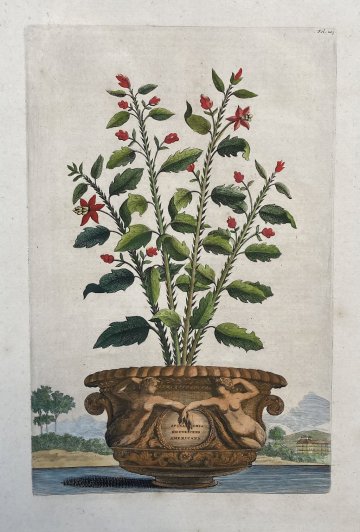(Red flowering plant in pot) Abraham Munting. Phytographica Curiosa...Utrecht 1696. Sold

Fig. 205 "Spinachia Fruescens Americana"
North American unidentified plant with lovely red flowers and glossy green leaves planted in handsome ornate terra cotta pot.
Until the end of the sixteenth century, botanical illustrations were produced primarily as guides to plants of medicinal use. The seventeenth century, however, saw a sort of "aesthetic revolution", as fruits and flowers were appreciated not only for their medicinal qualities, but for also for their visual appeal. It was also during this period that the "flower garden" developed distinct from herbal or medicinal garden. The cultivation and development of private gardens was considered a conspicuous luxury. With the expansion of trade and empire, many exotic species of plants, flowers and fruits were imported for these gardens. The documentation of these plants resulted in sumptuous volumes produced for the great libraries of Europe in order to satisfy the public’s interest in these curiosities. Abraham Munting, a Dutch botanist and medical doctor, produced the great work, Phytographic Curiosa...Exhibens Arborum...,Fruiticum, Herbarum, & Florum Icones... containing this image. It is one of the earliest obtainable botanical books. Munting's images are highly prized by collectors for their unusual and stunning depictions of plants shown larger than life, floating in the air above classical or idyllic landscapes.
17 3/4 x 11 inches, sheet.
Copperplate engraving, hand colored.
Excellent condition.
r
